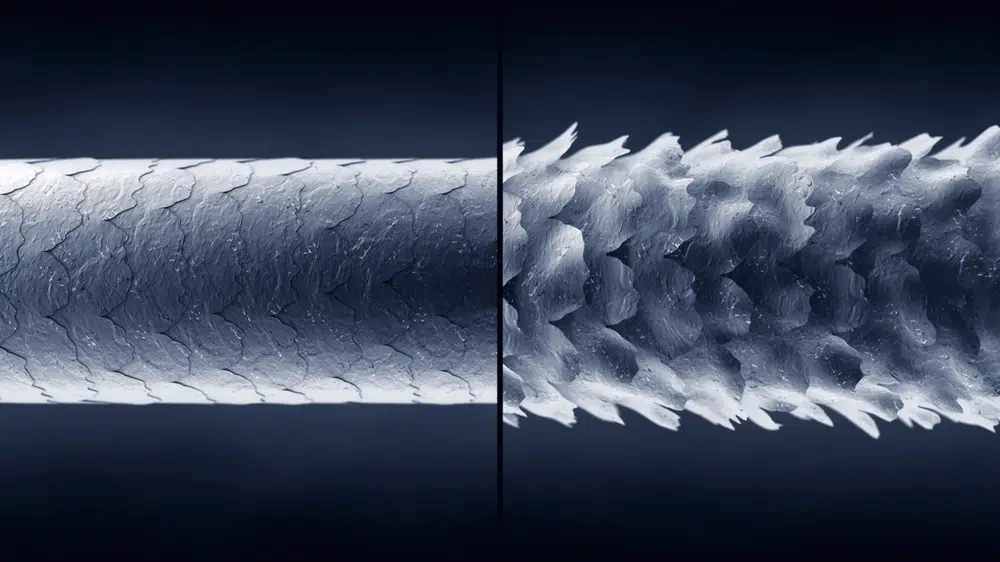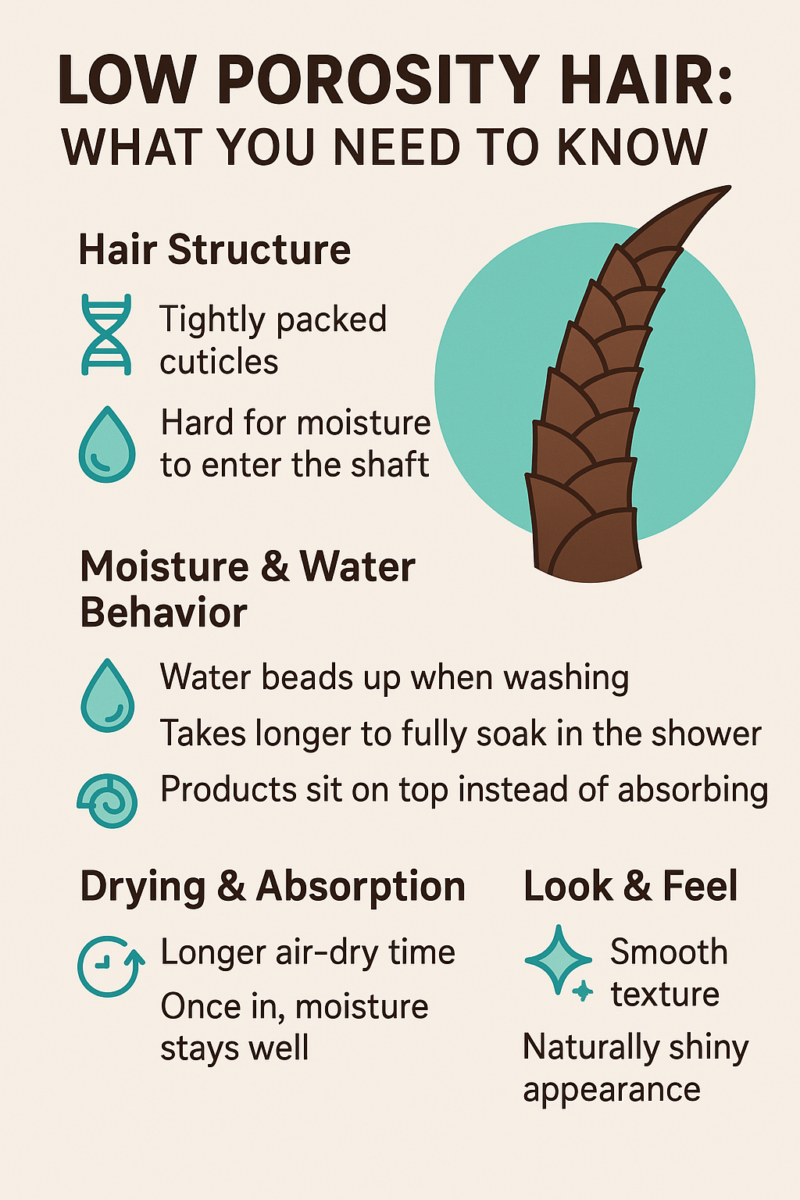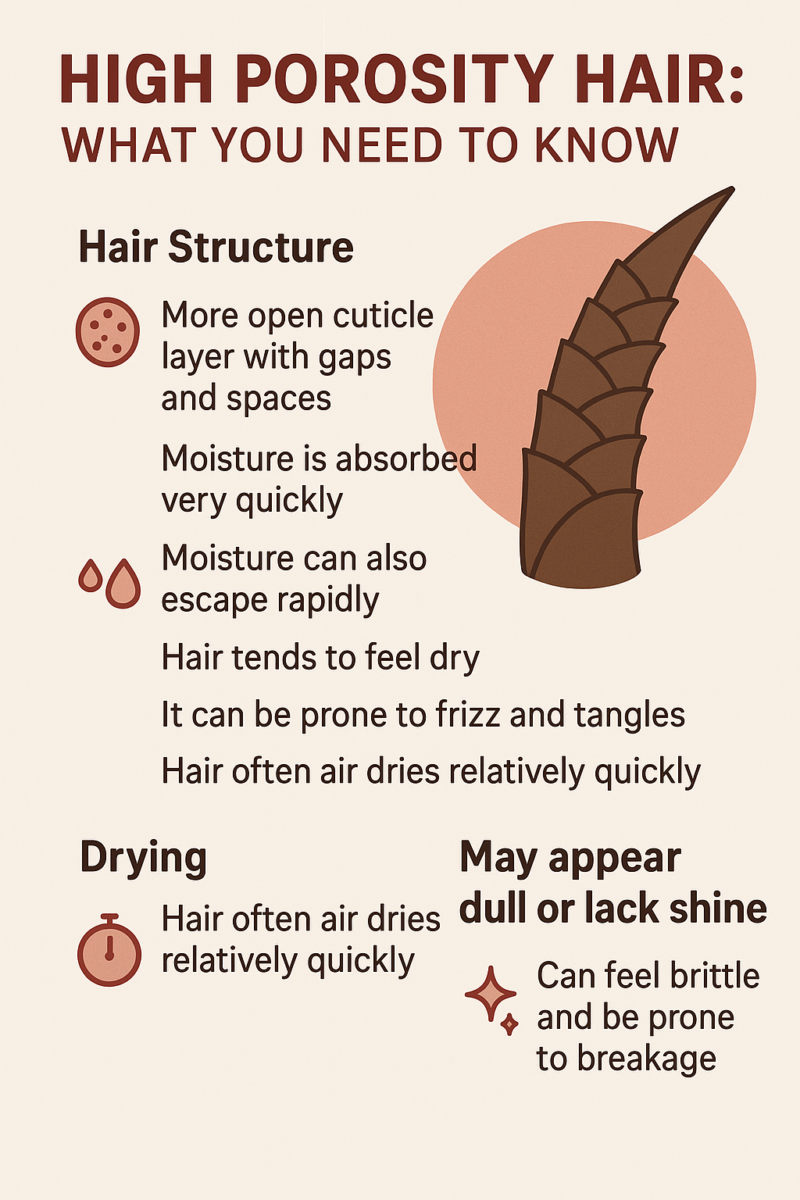If you laid all the strands of an average head of hair end-to-end, they could stretch for over 600 miles. That’s how fascinating hair is. And key to take proper care of it is understanding low vs. high porosity hair.
Let’s explore each of this two types of hair and how to cater to each for your best hair days!
What is Hair Porosity?
Hair porosity is about how well the outer layer of your hair, the cuticle, allows moisture to soak in and then how good it is at holding onto that hydration.
Low porosity hair has a tighter knit, making it harder for moisture to get in, while high porosity hair has a more open structure that drinks moisture up quickly but can also let it escape just as fast. It’s a fundamental trait that shapes how your hair behaves and what kind of TLC it needs.
Characteristics of Low Hair Porosity
If your hair has low porosity, you’ll often notice:
- Cuticles that are tightly packed together.
- Difficulty for moisture to penetrate the hair shaft.
- Products tend to sit on top of the hair rather than being quickly absorbed.
- Water may bead up on the hair when washing.
- It can take longer for hair to get fully wet in the shower.
- Hair tends to take longer to air dry.
- Once moisture is in, it’s generally retained well.
- Hair often appears smooth and can be quite shiny.
Characteristics of High Hair Porosity
High porosity hair often presents with:
- A more open cuticle layer with gaps and spaces.
- Moisture is absorbed very quickly.
- Moisture can also escape rapidly.
- Hair tends to feel dry.
- It can be prone to frizz and tangles.
- Hair often air dries relatively quickly.
- May appear dull or lack shine.
- Can feel brittle and be prone to breakage.
Most Common Low vs. High Porosity Hair Types
While porosity isn’t strictly tied to hair texture, certain patterns can emerge. Low porosity is often seen in straight or loosely wavy hair with a tight cuticle structure. The smoothness of the hair can make it harder for the cuticles to lift and absorb moisture.
High porosity, however, is more commonly found in curly and coily hair types. The natural bends and curves in these hair textures can cause the cuticle layer to be slightly raised, creating more points of entry for moisture but also more escape routes. Chemically treated or heat-damaged hair across all textures can also become highly porous.
Key Differences
The core difference between low and high porosity hair boils down to the structure and behavior of the hair’s cuticle. This fundamental difference dictates how each hair type responds to products, styling techniques, and overall care.
Feature | Low Porosity Hair | High Porosity Hair |
Cuticle Structure | Tightly packed, smooth, lies flat | Raised, open, with gaps and spaces |
Moisture Absorption | Difficult for moisture to penetrate | Absorbs moisture quickly |
Moisture Retention | Retains moisture well once absorbed | Loses moisture quickly |
Product Absorption | Products tend to sit on the surface | Products are absorbed quickly |
Reaction to Water | Water may bead up on the hair | Hair gets wet quickly |
Drying Time | Longer to air dry | Tends to air dry quickly |
Appearance | Often smooth and shiny | May appear dull; can be prone to frizz |
Common Hair Types | Often seen in straight or loosely wavy hair | More common in curly and coily hair; can occur in all |
Main Challenge | Getting moisture into the hair shaft | Keeping moisture in the hair shaft |
So, Both Low vs High Porosity Hair Are Dry?
Yes, that’s a key point of confusion! Both high porosity and low porosity hair can feel dry, but for different reasons:
- Low Porosity Hair: This type of hair has a tightly closed cuticle layer. It struggles to absorb moisture in the first place. So, even if you apply moisturizing products, they tend to sit on the surface, leading to dryness because the moisture isn’t getting inside the hair shaft. It’s like trying to pour water into a bottle with a very narrow opening – it just beads up on the outside.
- High Porosity Hair: This type of hair has a more open and often damaged cuticle layer with gaps and holes. It absorbs moisture very quickly, almost like a sponge. However, it loses that moisture just as quickly because the open cuticle doesn’t provide a good barrier to keep it in. So, you might moisturize your hair, and it feels good for a short while, but then it becomes dry and thirsty again as the moisture evaporates easily.
Think of it this way:
- Low porosity hair has trouble getting a drink.
- High porosity hair drinks quickly but can’t hold onto it.
Therefore, while the symptom of dryness is the same, the cause and therefore the solution are very different for each hair type.
If That’s So, How Do I Care for Low vs. High Porosity Hair?
Treating low and high porosity hair requires different approaches. Low porosity needs lightweight hydration and heat to aid absorption, plus regular clarifying. High porosity thrives on rich moisture, sealing products, and occasional protein to help retention.
Care Aspect | Low Porosity Hair | High Porosity Hair |
Moisturizing | Lightweight, water-based products (serums, liquid conditioners, light oils) | Richer, more moisturizing products (creams, butters) |
Deep Conditioning | Apply with mild heat (steamer, warm towel) to help cuticle lift | Can benefit from heat; focus on sealing afterward |
Sealing Moisture | Lighter oils sparingly if needed | Heavier oils and butters to lock in moisture effectively |
Protein | Usually not needed as frequently | Can be beneficial to fill cuticle gaps |
Cleansing | Clarify regularly to prevent buildup | Gentle cleansing to avoid stripping moisture |
Rinsing | Temperature less critical | Cool rinse can help to close the cuticle |
Product Application | Apply to damp hair for better absorption | Apply to damp hair to maximize absorption |
Is Low Better Than High Porosity Hair?
Neither low nor high porosity hair is inherently “better.” They simply have different characteristics that require tailored care routines. Low porosity hair can be strong and shiny when properly moisturized, while high porosity hair can be incredibly voluminous and absorb products beautifully when managed correctly. The “best” porosity is healthy, well-hydrated hair, regardless of its natural inclination. Understanding your hair’s porosity allows you to give it exactly what it needs to thrive.
Can I Change my Hair Porosity?
While your natural hair porosity is largely determined by genetics, it’s not entirely immutable. External factors and treatments can definitely impact it over time. Heat damage, chemical processing (like coloring, bleaching, and perms), and even excessive manipulation can lift the hair cuticle, often increasing porosity. While you can’t fundamentally change your hair’s inherent structure, you can take steps to manage and even temporarily alter its porosity through consistent and targeted care. Deep conditioning, protein treatments, and using products designed to seal the cuticle can all help to influence how your hair interacts with moisture.
Is High Porosity Hair Healthier?
High porosity hair isn’t inherently healthier or unhealthier than low porosity hair. Health depends more on the overall condition and care of the hair rather than just its porosity level. High porosity hair can be just as healthy, strong, and beautiful as low porosity hair, as long as it receives the right kind of attention and products to address its specific needs. Issues arise when high porosity hair isn’t properly moisturized and sealed, leading to dryness, breakage, and frizz. Similarly, low porosity hair can suffer from dryness and buildup if not cared for correctly. So, it’s all about understanding your hair’s unique needs and providing it with the love it deserves.
Curious about your hair’s porosity or have other hair and scalp concerns?
Dr. Serkan Aygin, a globally recognized expert in hair health based in Türkiye, and his experienced team are offering complimentary online consultations.
Get personalized advice tailored to your unique hair needs!



